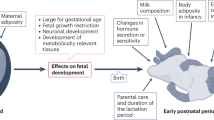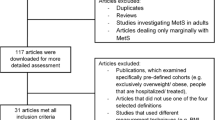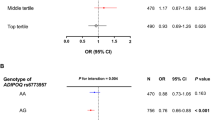Abstract
There is ample discussion of the relevance of the metabolic syndrome, the definition criteria, and predictive power. Nevertheless, along with the increasing prevalence of childhood obesity, the prevalence of the metabolic syndrome in obese children is reported at 30%, irrespective of the definition applied. Because children are otherwise relatively free of co-morbidities, they constitute an interesting population in which to study the sequence of events of obesity-related pathology. The adipocytokines appear to be important in this respect. Leptin was initially suggested as a promising “antiobesity” hormone. New concepts indicate that, in humans, leptin and its soluble receptor may be more important in states of energy deficiency rather than a predictor of the metabolic syndrome. Adiponectin, on the other hand, is not only related to obesity and insulin resistance, but appears to be the strongest predictor for metabolic syndrome, even in children. In newborns and infants, both adipocytokines occur in high concentrations, even though this cannot completely explain the increased risk for ensuing metabolic disease later in life. Finally, low-grade systemic inflammation may underlie the clustering of metabolic risk factors, but their role in children remains to be specified. Overall factors from the adipose tissue may constitute not only markers but also mediators of metabolic sequelae of obesity.
Similar content being viewed by others
Log in or create a free account to read this content
Gain free access to this article, as well as selected content from this journal and more on nature.com
or
Abbreviations
- SGA:
-
small for gestational age
- AGA:
-
adequate for gestational age
- SDS:
-
standard deviation score
- NASH:
-
nonalcoholic steatohepatitis
- sOB-R:
-
soluble leptin receptor
- CrP:
-
C-reactive protein
References
Reaven GM 1988 Banting Lecture 1988. Role of insulin resistance in human disease. Diabetes 37: 1595–1607
Grundy SM, Cleeman JI, Daniels SR, Donato KA, Eckel RH, Franklin BA, Gordon DJ, Krauss RM, Savage PJ, Smith SC Jr, Spertus JA, Costa F 2005 Diagnosis and management of the metabolic syndrome: an American Heart Association/National Heart, Lung, and Blood Institute Scientific Statement. Circulation 112: 2735–2752
Alberti KG, Zimmet PZ 1998 Definition, diagnosis and classification of diabetes mellitus and its complications. Part 1: diagnosis and classification of diabetes mellitus provisional report of a WHO consultation. Diabet Med 15: 539–553
National Cholesterol Education Program (NCEP) Expert Panel on Detection, Evaluation, and Treatment of High Blood Cholesterol in Adults (Adult Treatment Panel III) 2002 Third Report of the National Cholesterol Education Program (NCEP) Expert Panel on Detection, Evaluation, and Treatment of High Blood Cholesterol in Adults (Adult Treatment Panel III) final report. Circulation 106: 3143–3421
Kahn R, Buse J, Ferrannini E, Stern M 2005 The metabolic syndrome: time for a critical appraisal: joint statement from the American Diabetes Association and the European Association for the Study of Diabetes. Diabetes Care 28: 2289–2304
Kiess W, Galler A, Reich A, Müller G, Kapellen T, Deutscher J, Raile K, Kratzsch J 2001 Clinical aspects of obesity in childhood and adolescence. Obes Rev 2: 29–36
Berenson GS 2005 Obesity—a critical issue in preventive cardiology: the Bogalusa Heart Study. Prev Cardiol 8: 234–241
Kiess W, Gausche R, Keller A, Burmeister J, Willgerodt H, Keller E 2001 Computer-guided, population-based screening system for growth disorders (CrescNet) and on-line generation of normative data for growth and development. Horm Res 56: 59–66
Keller E, Gausche R, Meigen C, Keller A, Burmeister J, Kiess W 2002 Auxological computer based network for early detection of disorders of growth and weight attainment. J Pediatr Endocrinol Metab 15: 149–156
Sinha R, Fisch G, Teague B, Tamborlane WV, Banyas B, Allen K, Savoye M, Rieger V, Taksali S, Barbetta G, Sherwin RS, Caprio S 2002 Prevalence of impaired glucose tolerance among children and adolescents with marked obesity. N Engl J Med 346: 802–810
Reinehr T, Wabitsch M, Andler W, Beyer P, Böttner A, Chen-Stute A, Fromme C, Hampel O, Keller KM, Kilian U, Kolbe H, Lob-Corzilius T, Marg W, Mayer H, Mohnike K, Oepen J, Povel C, Richter B, Riedinger N, Schauerte G, Schmahlfeldt G, Siegfried W, Smuda P, Stachow R, Egmond-Frohlich A, Weiten J, Wiegand S, Witte S, Zindel V, Holl RW 2004 Medical care of obese children and adolescents. APV: a standardised multicentre documentation derived to study initial presentation and cardiovascular risk factors in patients transferred to specialised treatment institutions. Eur J Pediatr 163: 308–312
Wiegand S, Maikowski U, Blankenstein O, Biebermann H, Tarnow P, Grüters A 2004 Type 2 diabetes and impaired glucose tolerance in European children and adolescents with obesity—a problem that is no longer restricted to minority groups. Eur J Endocrinol 151: 199–206
Reich A, Müller G, Gelbrich G, Deutscher K, Godicke R, Kiess W 2003 Obesity and blood pressure—results from the examination of 2365 schoolchildren in Germany. Int J Obes Relat Metab Disord 27: 1459–1464
Reinehr T, Andler W, Denzer C, Siegried W, Mayer H, Wabitsch M 2005 Cardiovascular risk factors in overweight German children and adolescents: relation to gender, age and degree of overweight. Nutr Metab Cardiovasc Dis 15: 181–187
Weiss R, Dziura J, Burgert TS, Tamborlane WV, Taksali SE, Yeckel CW, Allen K, Lopes M, Savoye M, Morrison J, Sherwin RS, Caprio S 2004 Obesity and the metabolic syndrome in children and adolescents. N Engl J Med 350: 2362–2374
de Ferranti SD, Gauvreau K, Ludwig DS, Newburger JW, Rifai N 2006 Inflammation and changes in metabolic syndrome abnormalities in US adolescents: findings from the 1988-1994 and 1999-2000 National Health and Nutrition Examination Surveys. Clin Chem 52: 1325–1330
Lambert M, Paradis G, O'Loughlin J, Delvin EE, Hanley JA, Levy E 2004 Insulin resistance syndrome in a representative sample of children and adolescents from Quebec, Canada. Int J Obes Relat Metab Disord 28: 833–841
de Ferranti SD, Gauvreau K, Ludwig DS, Neufeld EJ, Newburger JW, Rifai N 2004 Prevalence of the metabolic syndrome in American adolescents: findings from the Third National Health and Nutrition Examination Survey. Circulation 19: 2494–2497
Zou CC, Liang L, Hong F, Fu JF, Zhao ZY 2005 Serum adiponectin, resistin levels and non-alcoholic fatty liver disease in obese children. Endocr J 52: 519–524
Chan DF, Li AM, Chu WC, Chan MH, Wong EM, Liu EK, Chan IH, Yin J, Lam CW, Fok TF, Nelson EA 2004 Hepatic steatosis in obese Chinese children. Int J Obes Relat Metab Disord 28: 1257–1263
Lavine JE, Schwimmer JB 2004 Nonalcoholic fatty liver disease in the pediatric population. Clin Liver Dis 8: 549–5ix
McCullough AJ 2006 Pathophysiology of nonalcoholic steatohepatitis. J Clin Gastroenterol 40: S17–S29
Siebler J, Galle PR 2006 Treatment of nonalcoholic fatty liver disease. World J Gastroenterol 12: 2161–2167
Hauner H 2005 Secretory factors from human adipose tissue and their functional role. Proc Nutr Soc 64: 163–169
Kershaw EE, Flier JS 2004 Adipose tissue as an endocrine organ. J Clin Endocrinol Metab 89: 2548–2556
Zhang Y, Proenca R, Maffei M, Barone M, Leopold L, Friedman JM 1994 Positional cloning of the mouse obese gene and its human homologue. Nature 372: 425–432
Halaas JL, Gajiwala KS, Maffei M, Cohen SL, Chait BT, Rabinowitz D, Lallone RL, Burley SK, Friedman JM 1995 Weight-reducing effects of the plasma protein encoded by the obese gene. Science 269: 543–546
Gura T 1999 Obesity research. Leptin not impressive in clinical trial. Science 286: 881–882
Koerner A, Kratzsch J, Kiess W 2005 Adipocytokines: leptin—the classical, resistin—the controversial, adiponectin—the promising, and more to come. Best Pract Res Clin Endocrinol Metab 19: 525–546
Lammert A, Kiess W, Böttner A, Glasow A, Kratzsch J 2001 Soluble leptin receptor represents the main leptin binding activity in human blood. Biochem Biophys Res Commun 283: 982–988
Zastrow O, Seidel B, Kiess W, Thiery J, Keller E, Böttner A, Kratzsch J 2003 The soluble leptin receptor is crucial for leptin action: evidence from clinical and experimental data. Int J Obes Relat Metab Disord 27: 1472–1478
Kratzsch J, Lammert A, Böttner A, Seidel B, Müller G, Thiery J, Hebebrand J, Kiess W 2002 Circulating soluble leptin receptor and free leptin index during childhood, puberty, and adolescence. J Clin Endocrinol Metab 87: 4587–4594
Reinehr T, Kratzsch J, Kiess W, Andler W 2005 Circulating soluble leptin receptor, leptin, and insulin resistance before and after weight loss in obese children. Int J Obes (Lond) 29: 1230–1235
Kratzsch J, Schubring C, Stitzel B, Böttner A, Berthold A, Thiery J, Kiess W 2005 Inverse changes in the serum levels of the soluble leptin receptor and leptin in neonates: relations to anthropometric data. J Clin Endocrinol Metab 90: 2212–2217
Kratzsch J, Knerr I, Galler A, Kapellen T, Raile K, Korner A, Thiery J, Dotsch J, Kiess W 2006 Metabolic decompensation in children with type 1 diabetes mellitus associated with increased serum levels of the soluble leptin receptor. Eur J Endocrinol 155: 609–614
Stein K, Vasquez-Garibay E, Kratzsch J, Romero-Velarde E, Jahreis G 2006 Influence of nutritional recovery on the leptin axis in severely malnourished children. J Clin Endocrinol Metab 91: 1021–1026
Flier JS 1998 Whats in a name? In search of leptins physiological role. J Clin Endocrinol Metab 83: 1407–1413
Hara K, Yamauchi T, Kadowaki T 2005 Adiponectin: an adipokine linking adipocytes and type 2 diabetes in humans. Curr Diab Rep 5: 136–140
Kadowaki T, Yamauchi T 2005 Adiponectin and adiponectin receptors. Endocr Rev 26: 439–451
Böttner A, Kratzsch J, Müller G, Kapellen TM, Blüher S, Keller E, Blüher M, Kiess W 2004 Gender differences of adiponectin levels develop during the progression of puberty and are related to serum androgen levels. J Clin Endocrinol Metab 89: 4053–4061
Reinehr T, Roth C, Menke T, Andler W 2004 Adiponectin before and after weight loss in obese children. J Clin Endocrinol Metab 89: 3790–3794
Chu NF, Shen MH, Wu DM, Lai CJ 2005 Relationship between plasma adiponectin levels and metabolic risk profiles in Taiwanese children. Obes Res 13: 2014–2020
Araki S, Dobashi K, Kubo K, Asayama K, Shirahata A 2006 High molecular weight, rather than total, adiponectin levels better reflect metabolic abnormalities associated with childhood obesity. J Clin Endocrinol Metab 91: 5113–5116
Pilz S, Horejsi R, Moller R, Almer G, Scharnagl H, Stojakovic T, Dimitrova R, Weihrauch G, Borkenstein M, Maerz W, Schauenstein K, Mangge H 2005 Early atherosclerosis in obese juveniles is associated with low serum levels of adiponectin. J Clin Endocrinol Metab 90: 4792–4796
Gilardini L, McTernan PG, Girola A, da Silva NF, Alberti L, Kumar S, Invitti C 2006 Adiponectin is a candidate marker of metabolic syndrome in obese children and adolescents. Atherosclerosis 189: 401–407
Ogawa Y, Kikuchi T, Nagasaki K, Hiura M, Tanaka Y, Uchiyama M 2005 Usefulness of serum adiponectin level as a diagnostic marker of metabolic syndrome in obese Japanese children. Hypertens Res 28: 51–57
Gregoire FM 2001 Adipocyte differentiation: from fibroblast to endocrine cell. Exp Biol Med (Maywood) 226: 997–1002
Körner A, Wabitsch M, Seidel B, Fischer-Posovszky P, Berthold A, Stumvoll M, Blüher M, Kratzsch J, Kiess W 2005 Adiponectin expression in humans is dependent on differentiation of adipocytes and down-regulated by humoral serum components of high molecular weight. Biochem Biophys Res Commun 337: 540–550
Soares AF, Guichardant M, Cozzone D, Bernoud-Hubac N, Bouzaidi-Tiali N, Lagarde M, Geloen A 2005 Effects of oxidative stress on adiponectin secretion and lactate production in 3T3-L1 adipocytes. Free Radic Biol Med 38: 882–889
Fasshauer M, Paschke R 2003 Regulation of adipocytokines and insulin resistance. Diabetologia 46: 1594–1603
Iwaki M, Matsuda M, Maeda N, Funahashi T, Matsuzawa Y, Makishima M, Shimomura I 2003 Induction of adiponectin, a fat-derived antidiabetic and antiatherogenic factor, by nuclear receptors. Diabetes 52: 1655–1663
Lihn AS, Pedersen SB, Richelsen B 2005 Adiponectin: action, regulation and association to insulin sensitivity. Obes Rev 6: 13–21
Degawa-Yamauchi M, Moss KA, Bovenkerk JE, Shankar SS, Morrison CL, Lelliott CJ, Vidal-Puig A, Jones R, Considine RV 2005 Regulation of adiponectin expression in human adipocytes: effects of adiposity, glucocorticoids, and tumor necrosis factor {alpha}. Obes Res 13: 662–669
Nilsson L, Binart N, Bohlooly Y, Bramnert M, Egecioglu E, Kindblom J, Kelly PA, Kopchick JJ, Ormandy CJ, Ling C, Billig H 2005 Prolactin and growth hormone regulate adiponectin secretion and receptor expression in adipose tissue. Biochem Biophys Res Commun 331: 1120–1126
Xu A, Chan KW, Hoo RL, Wang Y, Tan KC, Zhang J, Chen B, Lam MC, Tse C, Cooper GJ, Lam KS 2005 Testosterone selectively reduces the high molecular weight form of adiponectin by inhibiting its secretion from adipocytes. J Biol Chem 280: 18073–18080
Berg AH, Scherer PE 2005 Adipose tissue, inflammation, and cardiovascular disease. Circ Res 96: 939–949
Sjoholm A, Nystrom T 2005 Endothelial inflammation in insulin resistance. Lancet 365: 610–612
Homma Y 2004 Predictors of atherosclerosis. J Atheroscler Thromb 11: 265–270
Ford ES, Galuska DA, Gillespie C, Will JC, Giles WH, Dietz WH 2001 C-reactive protein and body mass index in children: findings from the Third National Health and Nutrition Examination Survey, 1988-1994. J Pediatr 138: 486–492
Moran A, Steffen LM, Jacobs DR Jr, Steinberger J, Pankow JS, Hong CP, Tracy RP, Sinaiko AR 2005 Relation of C-reactive protein to insulin resistance and cardiovascular risk factors in youth. Diabetes Care 28: 1763–1768
Lambert M, Delvin EE, Paradis G, O'Loughlin J, Hanley JA, Levy E 2004 C-reactive protein and features of the metabolic syndrome in a population-based sample of children and adolescents. Clin Chem 50: 1762–1768
Hiura M, Kikuchi T, Nagasaki K, Uchiyama M 2003 Elevation of serum C-reactive protein levels is associated with obesity in boys. Hypertens Res 26: 541–546
Bastard JP, Jardel C, Bruckert E, Blondy P, Capeau J, Laville M, Vidal H, Hainque B 2000 Elevated levels of interleukin 6 are reduced in serum and subcutaneous adipose tissue of obese women after weight loss. J Clin Endocrinol Metab 85: 3338–3342
Nemet D, Wang P, Funahashi T, Matsuzawa Y, Tanaka S, Engelman L, Cooper DM 2003 Adipocytokines, body composition, and fitness in children. Pediatr Res 53: 148–152
Dixon D, Goldberg R, Schneiderman N, Delamater A 2004 Gender differences in TNF-alpha levels among obese vs nonobese Latino children. Eur J Clin Nutr 58: 696–699
Zinman B, Hanley AJ, Harris SB, Kwan J, Fantus IG 1999 Circulating tumor necrosis factor-alpha concentrations in a native Canadian population with high rates of type 2 diabetes mellitus. J Clin Endocrinol Metab 84: 272–278
Gerber M, Böttner A, Seidel B, Lammert A, Bär J, Schuster E, Thiery J, Kiess W, Kratzsch J 2005 Serum resistin levels of obese and lean children and adolescents: biochemical analysis and clinical relevance. J Clin Endocrinol Metab 90: 4503–4509
Levy-Marchal C, Jaquet D 2004 Long-term metabolic consequences of being born small for gestational age. Pediatr Diabetes 5: 147–153
Jaquet D, Deghmoun S, Chevenne D, Collin D, Czernichow P, Levy-Marchal C 2005 Dynamic change in adiposity from fetal to postnatal life is involved in the metabolic syndrome associated with reduced fetal growth. Diabetologia 48: 849–855
Corbetta S, Bulfamante G, Cortelazzi D, Barresi V, Cetin I, Mantovani G, Bondioni S, Beck-Peccoz P, Spada A 2005 Adiponectin expression in human fetal tissues during mid- and late gestation. J Clin Endocrinol Metab 90: 2397–2402
Kotani Y, Yokota I, Kitamura S, Matsuda J, Naito E, Kuroda Y 2004 Plasma adiponectin levels in newborns are higher than those in adults and positively correlated with birth weight. Clin Endocrinol (Oxf) 61: 418–423
Tsai PJ, Yu CH, Hsu SP, Lee YH, Chiou CH, Hsu YW, Ho SC, Chu CH 2004 Cord plasma concentrations of adiponectin and leptin in healthy term neonates: positive correlation with birthweight and neonatal adiposity. Clin Endocrinol (Oxf) 61: 88–93
Iniguez G, Soto N, Avila A, Salazar T, Ong K, Dunger D, Mericq V 2004 Adiponectin levels in the first two years of life in a prospective cohort: relations with weight gain, leptin levels and insulin sensitivity. J Clin Endocrinol Metab 89: 5500–5503
Petridou E, Mantzoros CS, Belechri M, Skalkidou A, Dessypris N, Papathoma E, Salvanos H, Lee JH, Kedikoglou S, Chrousos G, Trichopoulos D 2005 Neonatal leptin levels are strongly associated with female gender, birth length, IGF-I levels and formula feeding. Clin Endocrinol (Oxf) 62: 366–371
Dunger D, Ong K 2004 Abundance of adiponectin in the newborn. Clin Endocrinol (Oxf) 61: 416–417
Kamoda T, Saitoh H, Saito M, Sugiura M, Matsui A 2004 Serum adiponectin concentrations in newborn infants in early postnatal life. Pediatr Res 56: 690–693
Butte NF, Comuzzie AG, Cole SA, Mehta NR, Cai G, Tejero M, Bastarrachea R, Smith EO 2005 Quantitative genetic analysis of the metabolic syndrome in Hispanic children. Pediatr Res 58: 1243–1248
Acknowledgements
The authors thank the children who participated in the studies. We also thank the technicians and study nurses for their help.
Author information
Authors and Affiliations
Corresponding author
Additional information
This work was supported by grants from the Deutsche Forschungsgemeinschaft (DFG) KFO-152: “Atherobesity,” KO 3512/1-1 (TP1), from the Interdisciplinary Center for Clinical Research at the University of Leipzig (B21 to A.K.), and from the European Community “PIONEER” (to W.K.). The Leipzig schoolchildren project was supported by unrestricted grants from Pfizer Pharma GmbH and Novo Nordisk GmbH to W.K. Part of the study was supported by a research grant from the German Hypertension Association to A.K.
Rights and permissions
About this article
Cite this article
Körner, A., Kratzsch, J., Gausche, R. et al. New Predictors of the Metabolic Syndrome in Children—Role of Adipocytokines. Pediatr Res 61, 640–645 (2007). https://doi.org/10.1203/01.pdr.0000262638.48304.ef
Received:
Accepted:
Issue date:
DOI: https://doi.org/10.1203/01.pdr.0000262638.48304.ef
This article is cited by
-
Health relevance of lowering postprandial glycaemia in the paediatric population through diet’: results from a multistakeholder workshop
European Journal of Nutrition (2023)
-
Mechanisms and risk factors of metabolic syndrome in children and adolescents
Endocrine (2023)
-
Enteral feeding advancement and growth until 5 years in extremely preterm infants
BMC Pediatrics (2021)
-
Klotho and fibroblast growth factors 19 and 21 serum concentrations in children and adolescents with normal body weight and obesity and their associations with metabolic parameters
BMC Pediatrics (2020)
-
Circulating growth-and-differentiation factor-15 in early life: relation to prenatal and postnatal growth and adiposity measurements
Pediatric Research (2020)



